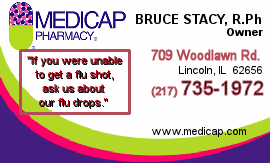|
Today is National Wear Red Day. Feb. 4
has been set aside by the National Heart, Lung, and Blood Institute
to call women's attention to their increasing risk of developing
heart disease. Men, you must
read this too, because the information to stay healthy is the same
for you. You also must share this information with the women you
care about.
[LDN]
Women and heart attack
If you're a woman, you may not believe you're as vulnerable to a
heart attack as men -- but you are. Women account for nearly half of
all heart attack deaths. Heart disease is the No. 1 killer of both
women and men.
There are differences in how women and men respond to a heart
attack. Women are less likely than men to believe they're having a
heart attack and more likely to delay in seeking emergency
treatment.

Further, women tend to be about 10 years older than men when they
have a heart attack. They are more likely to have other conditions,
such as diabetes, high blood pressure and congestive heart failure
-- making it all the more vital that they get proper treatment fast.
Women should learn the heart attack
warning signs. These are:
- Pain or discomfort in the center of the chest.
- Pain or discomfort in other areas of the upper body, including
the arms, back, neck, jaw or stomach.
- Other symptoms, such as a shortness of breath, breaking out in
a cold sweat, nausea or lightheadedness.
As with men, women's most common heart attack symptom is chest
pain or discomfort. But women are somewhat more likely than men to
experience some of the other common symptoms, particularly shortness
of breath, nausea and vomiting, and back or jaw pain.
If you feel heart attack symptoms, do not delay. Remember,
minutes matter! Do not wait for more than a few minutes -- five
minutes at most -- to call 9-1-1. Your family will benefit most if
you seek fast treatment.
Heart attacks
Coronary heart disease is the leading cause of death for both men
and women in the United States. Coronary heart disease is caused by
a narrowing of the coronary arteries that supply blood to the heart
and often results in a heart attack.

Each year, about 1.1 million Americans suffer a heart attack.
About 460,000 of those heart attacks are fatal. About half of those
deaths occur within one hour of the start of symptoms and before the
person reaches the hospital.
Fortunately, everyone can take steps to protect their heart --
and their life or that of someone else. The key is seeking medical
care as soon as possible.
The following information tells you about heart attack and the
steps you can take to increase your chances of survival. You'll
learn why a fast response to the signs of a heart attack is crucial
to save lives and limit heart damage.
What is a heart attack?
The heart works 24 hours a day, pumping oxygen and nutrient-rich
blood to the body. Blood is supplied to the heart through its
coronary arteries. In coronary heart disease, plaques or fatty
substances build up inside the walls of the arteries. The plaques
also attract blood components, which stick to the artery wall
lining. Called atherosclerosis, the process develops gradually, over
many years. It often begins early in life, even in childhood.
The fatty buildup or plaque can break open and lead to the
formation of a blood clot that seals the break. The clot reduces
blood flow. The cycle of fatty buildup, plaque rupture and blood
clot formation causes the coronary arteries to narrow, reducing
blood flow.
[to top of second column in this
article]
 |

When too little blood reaches the heart, the condition is called
ischemia. Chest pain, or angina, may occur. The pain can vary in
occurrence and be mild and intermittent, or more pronounced and
steady. It can be severe enough to make normal everyday activities
difficult. The same inadequate blood supply also may cause no
symptoms, a condition called silent ischemia.
If a blood clot suddenly cuts off most or all blood supply to the
heart, a heart attack results. Cells in the heart muscle that do not
receive enough oxygen-carrying blood begin to die. The more time
that passes without treatment to restore blood flow, the greater the
damage to the heart.
Who's at risk?
Heart attacks strike both men and women. However, some people are
more likely than others to have a heart attack because of their
"risk factors." Risk factors are behaviors or conditions that
increase the chance of a disease. Some of the risk factors for heart
attack are beyond your control, but most can be modified to help you
lower your risk of having a first -- or repeat -- heart attack.
Some factors that increase the risk of a heart attack are
controllable. Other factors are not.

Factors you cannot control
- Pre-existing coronary heart diseases, including a previous
heart attack, a prior angioplasty or bypass surgery, or angina.
- Age: In men, the risk increases after age 45; in women, the
risk increases after age 55.
- Family history of early heart disease -- a father or brother
diagnosed before age 55, or a mother or sister diagnosed before
age 65.
Factors you can control
You can reduce your risk of having a heart attack
-- even if you already have coronary heart disease or have had a
previous heart attack. The key is to take steps to prevent or
control your heart disease risk factors.
Six key steps to reduce heart attack risk
Taking these steps will reduce your
risk of having a heart attack:
- Stop smoking.
- Lower high blood pressure.
- Reduce high blood cholesterol.
- Aim for a healthy weight.
- Be physically active each day.
- Manage diabetes.
For more detailed information on the above actions, visit
"Reducing Heart Attack Risk."
Risk factors do not add their effects in a simple way. Rather,
they multiply each other's effects. So,
it is very important to prevent or
control risk factors that can be modified. If you have one
or more of these factors, see your health care provider to find out
how to reduce your risk of having a first or repeat heart attack.
Limiting heart muscle damage
Treatments for a heart attack work to open the blocked artery to
restore blood flow as fast as possible to prevent or limit damage to
the heart muscle and to lessen the chance of a repeat attack. The
main treatments are thrombolytic ("clot-busting") therapy, other
medications and special procedures such as angioplasty and coronary
artery bypass surgery.
To be most effective, these treatments must be given fast --
within one hour of the start
of heart attack symptoms. Acting fast can save your life and limit
damage to your heart.
Learn the signs -- but also remember: Even if you're not sure
it's a heart attack, you should still have it checked out. Fast
action can save lives -- maybe your own.
You can view online or order a copy
of
"The Healthy Heart Handbook for Women."
[Information compiled from
National Heart, Lung and Blood
Institute -- National Institutes of Health]
Other
sites to visit:
|



